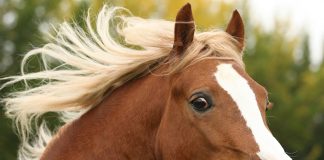 |
A bipartisan coalition of lawmakers has introduced legislation to ban the slaughter of American horses for human consumption overseas, as well as the export of American horses to other countries for slaughter. House Judiciary Committee Chairman John Conyers (D-Mich.) and Rep. Dan Burton (R-Ind.) introduced the bill, H.R. 6598, known as the Conyers-Burton Prevention of Equine Cruelty Act of 2008.
“Every day the Congress waits, there will be more torment and more suffering for America’s horses,” says Wayne Pacelle, president and CEO of The Humane Society of the United States (HSUS). “The horse is an American icon, and it is a betrayal of our responsibility to these animals to treat them like cheap commodities and send them across our borders for slaughter. We ask leaders in Congress for an up or down vote before the end of the session.”
State legislatures have recently acted to ban horse slaughter, shutting the last remaining foreign-owned horse slaughter plants in the U.S., but Congress still allows the export of live horses to Canada and Mexico for slaughter. More than 45,000 horses have been sent across U.S. borders to slaughter in Canada or Mexico so far in 2008, surpassing the number of exports to date in 2007.
Past congressional actions on horse slaughter have demonstrated a strong, bipartisan desire to prohibit killing horses for human consumption. In the 109th Congress, legislation to stop horse slaughter passed the House of Representatives numerous times by a margin of more than 100 votes, and passed the Senate by a more than two-to-one margin. But so far in the 110th Congress, the existing legislation, H.R. 503 by Reps. Jan Schakowsky (D-Ill.), Ed Whitfield (R-Ky.), Nick Rahall (D-W.Va.), and John Spratt (D-S.C.), and S. 311 by Sens. Mary Landrieu (D-La.) and John Ensign (R-Nev.), has not yet been enacted. Animal advocates blame the bill’s blockage on House committee leaders and Western senators, and they hope the new bill will advance quickly in Chairman Conyers’ House Judiciary Committee.
The HSUS documented the bloody trail of horse slaughter when investigators followed “killer buyers” transporting horses thousands of miles from auctions to feedlots to interstate highways. They also documented a barbaric method of slaughter on a kill floor in Juarez, Mexico. Thousands of horses are stabbed with short knives, a method that leaves them paralyzed and unable to breathe. The animals are still conscious as they are hoisted up by a chain and their throats slit.
Video footage from the HSUS’ horse slaughter investigations can be viewed and downloaded for broadcast or news websites at /redirect.php?location=http%3a%2f%2fvideo.hsus.org.
The HSUS is joined by members of Congress, the National Show Horse Registry, American Horse Defense Fund, Veterinarians for Equine Welfare, United States Equine Sanctuary & Rescue, American Walking Pony Association, American Indian Horse Registry, Palomino Horse Association, United States Eventing Association, National Thoroughbred Racing Association, National Steeplechase Association, Churchill Downs, and more than 500 endorsing organizations in support of the Conyers-Burton Prevention of Equine Cruelty Act.
The following is a timeline of events regarding recent horse slaughter legislation in the United States:
September 2007 – A three-judge panel from the U.S. Court of Appeals for the Seventh Circuit unanimously upholds the Illinois state law banning the slaughter of horses for human consumption in that state.
May 2007 – Governor Rod Blagojevich signs H.B. 1711, banning horse slaughter in Illinois.
May 2007 – The U.S. Supreme Court announces that it denies to consider an appeal of the lower court decision upholding Texas’ ban on the sale of horsemeat for human consumption.
April 2007 – U.S. House of Representatives passes H.R. 249 to restore a decades-old ban on the commercial sale and slaughter of wild horses first enacted under the Wild and Free-Roaming Horses and Burros Act of 1971. House vote: 277-137
April 2007 – U.S. Senate Commerce Committee voted 15-7 to approve S. 311 to ban horse slaughter and exports of horses for slaughter.
March 2007 – A federal district court orders the U.S. Department of Agriculture to stop inspecting horsemeat at the Cavel International slaughter plant, effectively closing the last operating horse slaughtering operation in the United States.
March 2007 – The United States Court of Appeals for the Fifth Circuit affirms decision upholding a Texas state law banning the sale of horsemeat for human consumption.
September 2006 – U.S. House of Representatives passes H.R. 503, the American Horse Slaughter Prevention Act. The 109th Congress adjourns before the Senate can consider the bill. House vote: 263-146
September 2005 – U.S. Senate approves the Ensign-Byrd Amendment to the FY 2006 Agriculture Appropriations Bill to prohibit the use of tax dollars to pay for inspections of horsemeat. Senate vote: 69-28
June 2005 – U.S. House of Representatives approves the Sweeney-Spratt-Rahall-Whitfield Amendment to the FY 2006 Agriculture Appropriations Bill to prohibit the use of tax dollars to pay for inspections of horsemeat. House vote: 269-158
May 2005 – U.S. House of Representatives approves the Rahall-Whitfield Amendment to the FY 2006 Interior Appropriations Bill to restore federal protections from commercial sale and slaughter to wild horses and burros. House vote: 249-159. The provision is stripped in conference from the final bill.







I totally disagree with horse slaughter,and think that it sure took long enough for this to happen!!!
all i have to say is about time!! horses are not a type of animal that is even logical to slaughter for food. besides the fact that most of these animals were bred by humans and those people should be responsible for them!!
great article
I hope they ban the mass slaughter of the mustangs too.
That’s great! Horse slaughter should not be allowed.
Glad something is being done!
First off, I’m against inhumane treatment of animals. However, I would not jump to conclusions about the culling of horses. The horses purchased for slaughter are the unwanted horses. If someone isn’t willing to spend more than $650 on a horse from auction, the horse isn’t meant to be a pet.
The equine industry is, unfortunately, plagued by poor breeding management. 98% of horses that go to slaughter are either Thoroughbred, Arabian or Quarterhorse. The reason: too many people are breeding for the wrong reasons. These horses make it to the auctions because of the fact that they have either hurt someone, are old, sick or are potentially dangerous.
In the long run, people who breed for the improvement of a line will lose out and have to sell. Why should good breeders be put out of business when there are irrisponsible breeders who breed their stallions to over 2000 mares a month? Thus, increasing the number of unwanted horses because of various reasons.
There will be a huge shortage of feed due to the increasing numbers of horses that the government will have to pay for by not slaughtering these unwanted horses. This will mean tax increases, sky-rocketing prices for hay and grain, and more unwanted animals that will have no where to go and are starving to death.
We should seriously re-consider opening the slaughter plants in the U.S. under the government for regulation. It’s better to slaughter them humanely, than to live a pipe-dream that the U.S. can afford to pay for the feeding and care of all of these unwanted animals.
If there is an eteranl Heaven may it be graced with horses. If there is an eternal Hell may the butchers enjoy their stay…